
Diego María de la Concepción Juan Nepomuceno Estanislao de la Rivera y Barrientos Acosta y Rodríguez, known as Diego Rivera, was a prominent Mexican painter. His large frescoes helped establish the mural movement in Mexican and international art.

Hillsborough is an incorporated town in San Mateo County, California, in the San Francisco Bay Area. It is located 17 miles (27 km) south of San Francisco on the San Francisco Peninsula, bordered by Burlingame to the north, San Mateo to the east, Highlands-Baywood Park to the south, and Interstate 280 to the west. The population was 10,825 as of 2010.

Richard Joseph Neutra was a Jewish Austrian-American architect. Living and building for the majority of his career in Southern California, he came to be considered among the most prominent and important modernist architects.

Coit Tower is a 210-foot (64 m) tower in the Telegraph Hill neighborhood of San Francisco, California, offering panoramic views over the city and the bay. The tower, in the city's Pioneer Park, was built between 1932 and 1933 using Lillie Hitchcock Coit's bequest to beautify the city of San Francisco. It was added to the National Register of Historic Places on January 29, 2008.
Arthur Brown Jr. (1874–1957) was an American architect, based in San Francisco and designer of many of its landmarks.

The Case Study Houses were experiments in American residential architecture sponsored by Arts & Architecture magazine, which commissioned major architects of the day, including Richard Neutra, Raphael Soriano, Craig Ellwood, Charles and Ray Eames, Pierre Koenig, Eero Saarinen, A. Quincy Jones, Edward Killingsworth, and Ralph Rapson to design and build inexpensive and efficient model homes for the United States residential housing boom caused by the end of World War II and the return of millions of soldiers.

Streamline Moderne is an international style of Art Deco architecture and design that emerged in the 1930s. It was inspired by aerodynamic design. Streamline architecture emphasized curving forms, long horizontal lines, and sometimes nautical elements. In industrial design, it was used in railroad locomotives, telephones, toasters, buses, appliances, and other devices to give the impression of sleekness and modernity.

Carolands Chateau is a 46,050-square-foot (4,278 m2), 4.5 floor, 98 room mansion on 5.83 acres (2.36 ha) in Hillsborough, California. An example of American Renaissance and Beaux-Arts design, the building is a California Historical Landmark and is listed on the National Register of Historic Places. Carolands is one of the last of the houses built during the Gilded Age, a period of great mansion-building that included famous houses of the Vanderbilt family, such as Marble House, Biltmore Estate and The Breakers, and stately California houses such as Filoli and the Huntington family's mansions.
Joseph Leopold Eichler was a 20th-century post-war American real estate developer known for developing distinctive residential subdivisions of Mid-century modern style tract housing in California. He was one of the influential advocates of bringing modern architecture from custom residences and large corporate buildings to general public availability. His company and developments remain in the Greater San Francisco Bay Area and Greater Los Angeles.
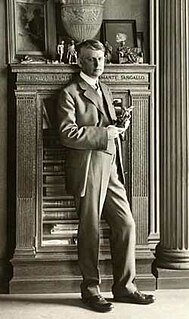
Willis Jefferson Polk was an American architect best known for his work in San Francisco, California. For ten years, he was the West Coast representative of D.H. Burnham & Company. In 1915, Polk oversaw the architectural committee for the Panama–Pacific International Exposition (PPIE).
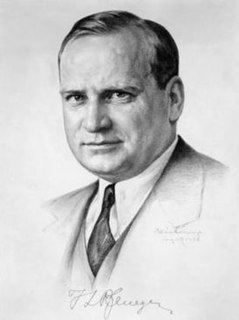
Timothy Ludwig Pflueger was a prominent architect, interior designer and architectural lighting designer in the San Francisco Bay Area in the first half of the 20th century. Together with James R. Miller, Pflueger designed some of the leading skyscrapers and movie theaters in San Francisco in the 1920s, and his works featured art by challenging new artists such as Ralph Stackpole and Diego Rivera. Rather than breaking new ground with his designs, Pflueger captured the spirit of the times and refined it, adding a distinct personal flair. His work influenced later architects such as Pietro Belluschi.

The Kaufmann Desert House, or simply the Kaufmann House, is a house located in Palm Springs, California, that was designed by architect Richard Neutra in 1946. It was commissioned by Edgar J. Kaufmann, Snr, a businessman who also commissioned Fallingwater by Frank Lloyd Wright.

Art in Action was an exhibit of artists at work displayed for four months in the summer of 1940 at the Golden Gate International Exposition (GGIE) held on Treasure Island. Many famous artists took part in the exhibit, including Dudley C. Carter, woodcarver and Diego Rivera, muralist. Rivera painted his monumental work Pan American Unity at Art in Action.
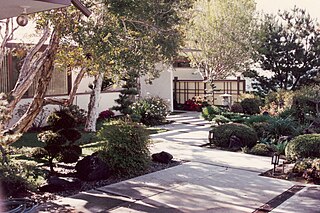
The Clark House is an International-Modernist Style residence designed by American Modernist architect Richard Neutra, and built in 1957 in Pasadena, California, United States.

Esther Baum Born was an American architect, author and architectural photographer who lived and worked in the San Francisco Bay Area, New York, and Mexico. With her husband, Ernest Born, she wrote The New Architecture in Mexico, which also includes articles on the painting and sculpture by Justino Fernández. She traveled in Mexico for 10 months, photographing and drawing historic and modern buildings, ultimately attracting global attention to the dawn of Mexico's modern architecture. Working mostly behind the scenes, she was integral to the success of the Ernest Born architecture firm.
Pan American Unity is a mural painted by Mexican artist and muralist Diego Rivera for the Art in Action exhibition at Treasure Island's Golden Gate International Exposition (GGIE) in San Francisco, California in 1940. This work was the centerpiece of the Art In Action exhibit, which featured many different artists engaged in creating works during the Exposition while the public watched.

Emmy Lou Packard also known as Betty Lou Packard (1914–1998) was a Californian post-war artist known for painting, printmaking and murals.

The Sidney Kahn House is a four-story residential building in Telegraph Hill, San Francisco, California designed by architect Richard Neutra in 1939. The building is Neutra's most famous house in San Francisco.
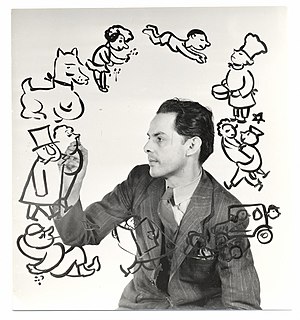
Antonio "Tony" Sotomayor (1902–1985) was a Bolivian-born American artist and educator, known as a painter and muralist. He also worked as a illustrator, caricaturist, designer, and ceramicist. He was nicknamed San Francisco's 'Artist Laureate'.
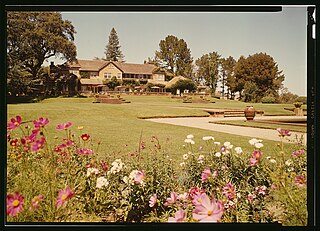
The Mortimer Fleishhacker House, also known as Green Gables, the Fleishhacker Estate, or the Mortimer Fleishhacker Country House is a historic estate with an English manor house, built between 1911 and 1935, and located at 329 Albion Avenue in Woodside, California. The house has been listed on the National Register of Historic Places since September 26, 1986.

















